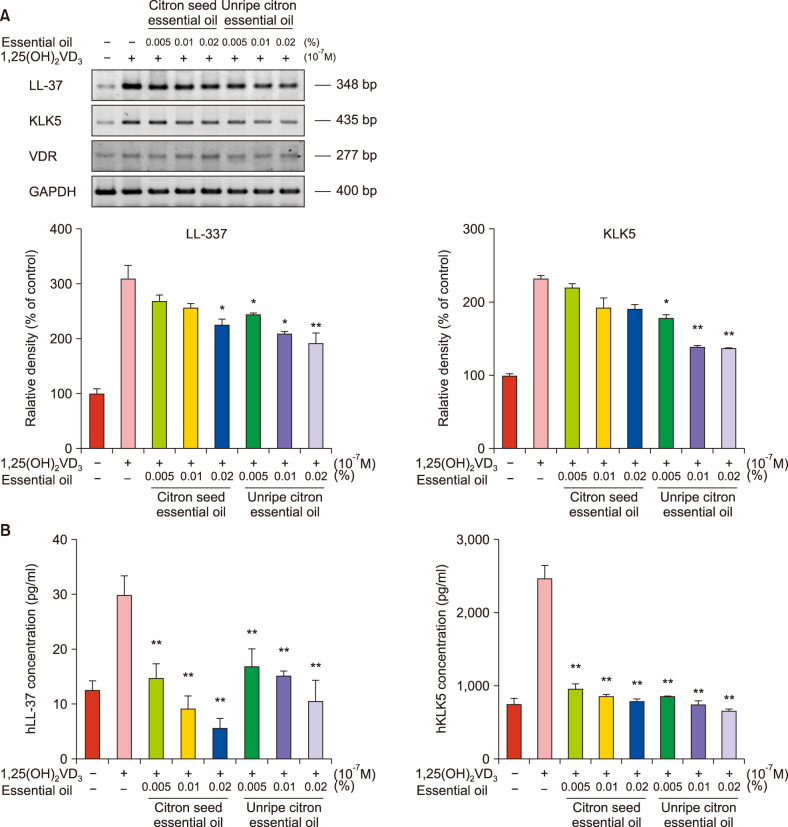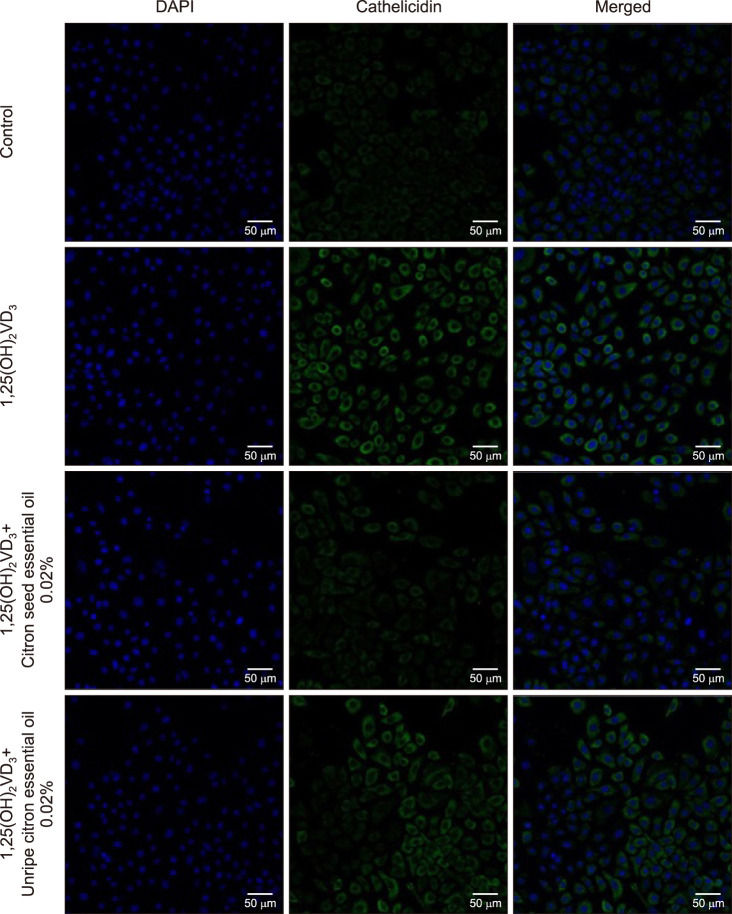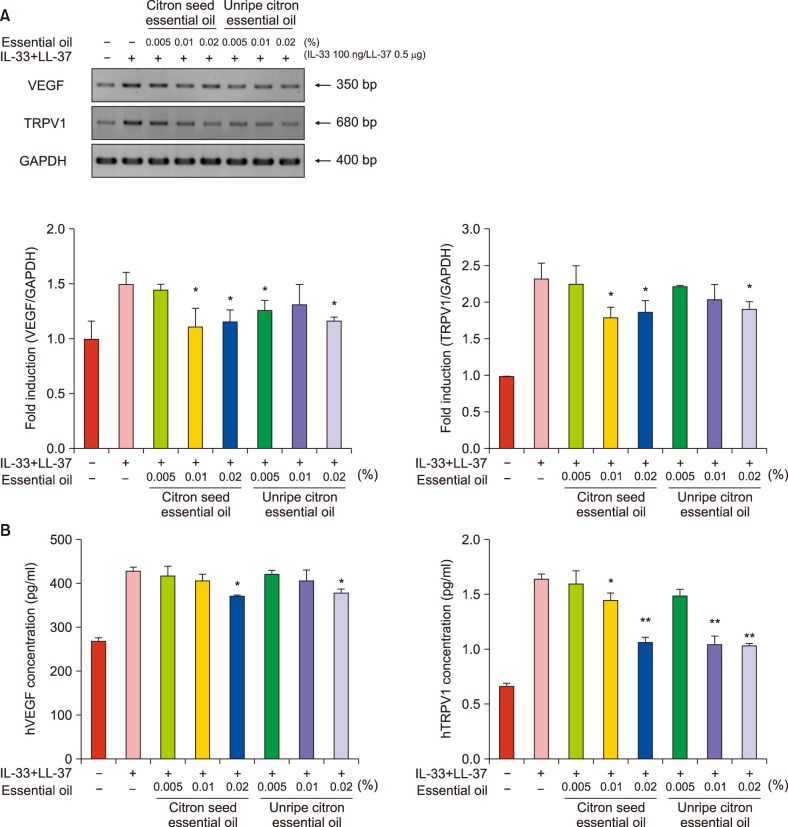Ann Dermatol.
2018 Dec;30(6):653-661. 10.5021/ad.2018.30.6.653.
Citron Essential Oils Alleviate the Mediators Related to Rosacea Pathophysiology in Epidermal Keratinocytes
- Affiliations
-
- 1Department of Dermatology, Chonnam National University Medical School, Gwangju, Korea. jbmlee@jnu.ac.kr
- KMID: 2428920
- DOI: http://doi.org/10.5021/ad.2018.30.6.653
Abstract
- BACKGROUND
Citron is well known for an abundance of antioxidative and anti-inflammatory ingredients such as vitamin C, polyphenol compounds, flavonoids, and limonoids.
OBJECTIVE
In this study, we aimed to evaluate the effects of citron essential oils on rosacea mediators in activated keratinocytes in vitro.
METHODS
Normal human epidermal keratinocytes (NHEKs) were stimulated with 1α, 25-dihydroxyvitamin D3 (VD3) and interleukin 33 (IL-33) with LL-37 to induce rosacea mediators such as kallikrein 5 (KLK5), cathelicidin, vascular endothelial growth factor (VEGF), and transient receptor potential vanilloid 1 (TRPV1). These mediators were analyzed by performing reverse-transcription polymerase chain reaction (PCR), quantitative real-time PCR, immunocytofluorescence and enzyme-linked immunosorbent assay after NHEKs were treated with citron seed and unripe citron essential oils.
RESULTS
The messenger RNA (mRNA) and protein levels of KLK5 and LL-37 induced by VD3 were suppressed by citron seed and unripe citron essential oils. Furthermore, the mRNA and protein levels of VEGF and TRPV1 induced by IL-33 with LL-37 were also suppressed by citron essential oils.
CONCLUSION
These results show that citron essential oils have suppressive effects on rosacea mediators in activated epidermal keratinocytes, which indicates that the citron essential oils may be valuable adjuvant therapeutic agents for rosacea.
Keyword
MeSH Terms
-
Ascorbic Acid
Enzyme-Linked Immunosorbent Assay
Flavonoids
Humans
In Vitro Techniques
Interleukin-33
Kallikreins
Keratinocytes*
Limonins
Oils, Volatile*
Polymerase Chain Reaction
Real-Time Polymerase Chain Reaction
RNA, Messenger
Rosacea*
Vascular Endothelial Growth Factor A
Ascorbic Acid
Flavonoids
Interleukin-33
Kallikreins
Limonins
Oils, Volatile
RNA, Messenger
Vascular Endothelial Growth Factor A
Figure
Reference
-
1. Sawamura M, Wu Y, Fujiwara C, Urushibata M. Inhibitory effect of yuzu essential oil on the formation of N-nitrosodimethylamine in vegetables. J Agric Food Chem. 2005; 53:4281–4287. PMID: 15884872.
Article2. Yoo KM, Lee KW, Park JB, Lee HJ, Hwang IK. Variation in major antioxidants and total antioxidant activity of Yuzu (Citrus junos Sieb ex Tanaka) during maturation and between cultivars. J Agric Food Chem. 2004; 52:5907–5913. PMID: 15366841.
Article3. Zou Z, Xi W, Hu Y, Nie C, Zhou Z. Antioxidant activity of citrus fruits. Food Chem. 2016; 196:885–896. PMID: 26593569.
Article4. Hirota R, Roger NN, Nakamura H, Song HS, Sawamura M, Suganuma N. Anti-inflammatory Effects of limonene from yuzu (Citrus junos Tanaka) essential oil on eosinophils. J Food Sci. 2010; 75:H87–H92. PMID: 20492298.5. Crawford GH, Pelle MT, James WD. Rosacea: I. Etiology, pathogenesis, and subtype classification. J Am Acad Dermatol. 2004; 51:327–341. PMID: 15337973.
Article6. Schwab VD, Sulk M, Seeliger S, Nowak P, Aubert J, Mess C, et al. Neurovascular and neuroimmune aspects in the pathophysiology of rosacea. J Investig Dermatol Symp Proc. 2011; 15:53–62.
Article7. Two AM, Del Rosso JQ. Kallikrein 5-mediated inflammation in rosacea: clinically relevant correlations with acute and chronic manifestations in rosacea and how individual treatments may provide therapeutic benefit. J Clin Aesthet Dermatol. 2014; 7:20–25.8. Steinhoff M, Schauber J, Leyden JJ. New insights into rosacea pathophysiology: a review of recent findings. J Am Acad Dermatol. 2013; 69:S15–S26. PMID: 24229632.
Article9. Yamasaki K, Di Nardo A, Bardan A, Murakami M, Ohtake T, Coda A, et al. Increased serine protease activity and cathelicidin promotes skin inflammation in rosacea. Nat Med. 2007; 13:975–980. PMID: 17676051.
Article10. Yamasaki K, Schauber J, Coda A, Lin H, Dorschner RA, Schechter NM, et al. Kallikrein-mediated proteolysis regulates the antimicrobial effects of cathelicidins in skin. FASEB J. 2006; 20:2068–2080. PMID: 17012259.
Article11. Morizane S, Yamasaki K, Mühleisen B, Kotol PF, Murakami M, Aoyama Y, et al. Cathelicidin antimicrobial peptide LL-37 in psoriasis enables keratinocyte reactivity against TLR9 ligands. J Invest Dermatol. 2012; 132:135–143. PMID: 21850017.
Article12. Schauber J, Gallo RL. The vitamin D pathway: a new target for control of the skin's immune response? Exp Dermatol. 2008; 17:633–639. PMID: 18573153.
Article13. Pecze L, Szabó K, Széll M, Jósvay K, Kaszás K, Kúsz E, et al. Human keratinocytes are vanilloid resistant. PLoS One. 2008; 3:e3419. PMID: 18852901.
Article14. Caterina MJ, Schumacher MA, Tominaga M, Rosen TA, Levine JD, Julius D. The capsaicin receptor: a heat-activated ion channel in the pain pathway. Nature. 1997; 389:816–824. PMID: 9349813.
Article15. Sulk M, Seeliger S, Aubert J, Schwab VD, Cevikbas F, Rivier M, et al. Distribution and expression of non-neuronal transient receptor potential (TRPV) ion channels in rosacea. J Invest Dermatol. 2012; 132:1253–1262. PMID: 22189789.
Article16. Huggenberger R, Detmar M. The cutaneous vascular system in chronic skin inflammation. J Investig Dermatol Symp Proc. 2011; 15:24–32.
Article17. Gomaa AH, Yaar M, Eyada MM, Bhawan J. Lymphangiogenesis and angiogenesis in non-phymatous rosacea. J Cutan Pathol. 2007; 34:748–753. PMID: 17880579.
Article18. Balato A, Lembo S, Mattii M, Schiattarella M, Marino R, De Paulis A, et al. IL-33 is secreted by psoriatic keratinocytes and induces pro-inflammatory cytokines via keratinocyte and mast cell activation. Exp Dermatol. 2012; 21:892–894. PMID: 23163661.
Article19. Borelli C, Becker B, Thude S, Fehrenbacher B, Isermann D. Dermasence refining gel modulates pathogenetic factors of rosacea in vitro. J Cosmet Dermatol. 2017; 16:e31–e36. PMID: 28349651.
Article20. Denizot F, Lang R. Rapid colorimetric assay for cell growth and survival: modifications to the tetrazolium dye procedure giving improved sensitivity and reliability. J Immunol Methods. 1986; 89:271–277. PMID: 3486233.21. Schauber J, Dorschner RA, Coda AB, Büchau AS, Liu PT, Kiken D, et al. Injury enhances TLR2 function and antimicrobial peptide expression through a vitamin D–dependent mechanism. J Clin Invest. 2007; 117:803–811. PMID: 17290304.
Article22. Thibaut de Ménonville ST, Rosignoli C, Soares E, Roquet M, Bertino B, Chappuis JP, et al. Topical treatment of rosacea with ivermectin inhibits gene expression of cathelicidin innate immune mediators, LL-37 and KLK5, in reconstructed and ex vivo skin models. Dermatol Ther (Heidelb). 2017; 7:213–225. PMID: 28243927.
Article23. Lee JB, Bae SH, Moon KR, Na EY, Yun SJ, Lee SC. Light-emitting diodes downregulate cathelicidin, kallikrein and toll-like receptor 2 expressions in keratinocytes and rosacea-like mouse skin. Exp Dermatol. 2016; 25:956–961. PMID: 27315464.
Article24. Morizane S, Yamasaki K, Kabigting FD, Gallo RL. Kallikrein expression and cathelicidin processing are independently controlled in keratinocytes by calcium, vitamin D(3), and retinoic acid. J Invest Dermatol. 2010; 130:1297–1306. PMID: 20090765.
Article25. Hertog MG, Feskens EJ, Hollman PC, Katan MB, Kromhout D. Dietary antioxidant flavonoids and risk of coronary heart disease: the Zutphen Elderly Study. Lancet. 1993; 342:1007–1011. PMID: 8105262.
Article26. Vinson JA, Su X, Zubik L, Bose P. Phenol antioxidant quantity and quality in foods: fruits. J Agric Food Chem. 2001; 49:5315–5321. PMID: 11714322.
Article27. Lee SL, Seo CS, Kim JH, Shin HK. Contents of poncirin and naringin in fruit of poncirus trifoliata according to different harvesting times and locations for two years. Korean J Pharmacogn. 2011; 42:138–143.28. Yang HS, Eun JB. Fermentation and sensory characteristics of Korean traditional fermented liquor (makgeolli) added with citron (Citrus junos SIEB ex TANAKA) juice. Korean J Food Sci Technol. 2011; 43:438–445.
Article29. Woo DH. Stabilization to sunlight of natural coloring matter by soluble methyl-hesperidin. Korean J Food Sci Technol. 2000; 32:50–55.30. Kim SY, Shin KS. Evaluation of physiological activities of the citron (Citrus junos Sieb. ex TANAKA) seed extracts. Prev Nutr Food Sci. 2013; 18:196–202. PMID: 24471132.
Article31. Woo KL, Kim JI, Kim MC, Chang DK. Determination of flavonoid and limonoid compounds in citron (Citrus junos Sieb. et Tanaka) seeds by HPLC and HPLC/MS. J Korean Soc Food Sci Nutr. 2006; 35:353–358.32. Manners GD. Citrus limonoids: analysis, bioactivity, and biomedical prospects. J Agric Food Chem. 2007; 55:8285–8294. PMID: 17892257.
Article33. Miller EG, Gonzales-Sanders AP, Couvillon AM, Wright JM, Hasegawa S, Lam LK. Inhibition of hamster buccal pouch carcinogenesis by limonin 17-beta-D-glucopyranoside. Nutr Cancer. 1992; 17:1–7. PMID: 1574440.34. El-Readi MZ, Hamdan D, Farrag N, El-Shazly A, Wink M. Inhibition of P-glycoprotein activity by limonin and other secondary metabolites from citrus species in human colon and leukaemia cell lines. Eur J Pharmacol. 2010; 626:139–145. PMID: 19782062.
Article35. Langeswaran K, Jagadeesan AJ, Revathy R, Balasubramanian MP. Chemotherapeutic efficacy of limonin against Aflatoxin B1 induced primary hepatocarcinogenesis in Wistar albino rats. Biomed Aging Pathol. 2012; 2:206–211.
Article36. Giamperi L, Fraternale D, Bucchini A, Ricci D. Antioxidant activity of citrus paradisi seeds glyceric extract. Fitoterapia. 2004; 75:221–224. PMID: 15030930.
Article37. Koczulla R, von Degenfeld G, Kupatt C, Krötz F, Zahler S, Gloe T, et al. An angiogenic role for the human peptide antibiotic LL-37/hCAP-18. J Clin Invest. 2003; 111:1665–1672. PMID: 12782669.
Article38. Two AM, Wu W, Gallo RL, Hata TR. Rosacea: part I. Introduction, categorization, histology, pathogenesis, and risk factors. J Am Acad Dermatol. 2015; 72:749–758. PMID: 25890455.39. Earley S. Vanilloid and melastatin transient receptor potential channels in vascular smooth muscle. Microcirculation. 2010; 17:237–249. PMID: 20536737.
Article
- Full Text Links
- Actions
-
Cited
- CITED
-
- Close
- Share
- Similar articles
-
- Hyaluronan Oligosaccharides Improve Rosacea-Like Phenotype through Anti-Inflammatory and Epidermal Barrier-Improving Effects
- The Effect of Capsaicin on Neuroinflammatory Mediators of Rosacea
- In vitro Study and Clinical Trial of Natural Essential Oils and Extract Against Malassezia Species
- Antifungal Activity and Inhibitory Modes of Volatile Vapours of Essential Oils
- The Suppressive Effect of Essential Oils from Plants on Interleukin-8 from Airway Epithelial Cell




